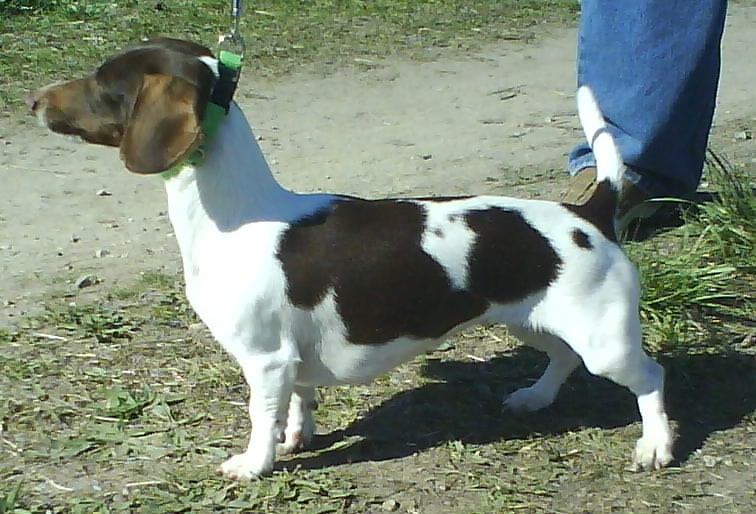Click to Skip Ahead
The Dachshund is an old breed with a history dating back to 15th Century Germany. It comes in two sizes: standard and toy; three coats: short-haired, long-haired, and wire-haired; and can come in a wide range of colors and patterns, including piebald.
Breed Overview
Height:
14 – 19 inches (standard); 12-15 inches (miniature)
Weight:
16 – 32 pounds (standard); under 11 pounds (miniature)
Lifespan:
12 – 16 years
Colors:
Solid red, black, and tan, red and tan, merle
Suitable for:
Families with older children
Temperament:
Devoted, playful, curious
True piebald Dachshunds are recognized by the AKC and other clubs, but extreme piebalds and those with blue eyes are not officially recognized. The piebald shares most of the same traits and history as the general breed, although those with large patches of white on their body can prove to be more prone to health conditions and illnesses.
Read on for more information about the Dachshund and, in particular, those with a piebald coat.
Dachshund Characteristics
The Earliest Records of Piebald Dachshunds in History
The Dachshund can trace its roots back to 15th Century Germany, where two sizes of the dog were bred for hunting burrowing animals like badgers and foxes. They were bred with a long back and short legs so that they could more easily get into foxholes and setts. They were also bred to be muscular, have a strong sense of smell, and be able to dig.
The breed was introduced to the UK in the mid 19th Century when Prince Albert introduced his wife, Queen Victoria, to the German breed. Her love for them soon saw their popularity spread to the rest of the country.
It wasn’t until the late 19th Century that the Dachshund was first introduced to the U.S., however, but they were recognized by the American Kennel Club in 1885. Their recognition included all three coat varieties, both sizes, and a variety of different colors and markings, including the piebald marking.

How Piebald Dachshunds Gained Popularity
There are several likely reasons that the Dachshund gained popularity around the world. Initially, it gained popularity in its home country because the scent hound was very good at hunting burrowing animals.
It became popular in the UK when Prince Albert introduced his wife, Queen Victoria, to the breed. She went on to own several Dachshunds over her life. The breed featured in royal pictures and even in Victoria’s personal correspondence.
While many European countries had their own breeds that were adept at hunting badgers and foxes, the U.S. welcomed the Dachshund in the 19th Century, again for its hunting prowess.
Unfortunately, following World War II, a change of name to Badger Hound did not stop the breed from losing some of its popularity, but the Dachshund has once again become a popular breed for its loving and loyal nature.
The piebald Dachshund is not as popular as the standard brown and black color, but some owners do appreciate its unique appearance.
Formal Recognition of Piebald Dachshunds
The Dachshund was introduced to the U.S. in the late 19th Century and was formally recognized by the American Kennel Club in 1885. At this time, the AKC recognized the standard and toy sizes. They also recognized short-haired, long-haired, and wire-haired varieties of the breed, as well as a variety of different colors and markings including the piebald.

Top 3 Unique Facts About Piebald Dachshunds
1. Those With Blue Eyes Are Not Considered True Piebald Dachshunds
To be recognized as a piebald Dachshund, the dog must have colored flecks or spots on a white undercoat. Those with no markings on the body, and only markings on the head, are called extreme piebald and are not officially recognized. If one has blue eyes, it is not considered a true piebald Dachshund, either. They can only have dark-colored eyes.
2. Piebald Dachshunds With a Lot of White Are More Prone to Certain Health Conditions
It is believed that piebald Dachshunds with large patches of white are more prone to certain health conditions. The breed, in general, is prone to spinal and skeletal conditions including intervertebral disc disease and bloat.
3. Dachshunds Can Be Prone to Digging
The Dachshund was originally bred to hunt burrowing animals. One of the skills that they needed for this was to be able to get into and dig further into burrows and holes. Even if your dog does not chase badgers and foxes, it may still be prone to burrowing, which is why you will find Dachshunds digging their blankets and hiding underneath cushions.
Does a Piebald Dachshund Make a Good Pet?
Dachshunds have become one of the most popular dog breeds to keep as pets. They are loyal and loving, get along with virtually everybody, and are energetic enough to be considered good companions for children, without needing too excessive a daily workout. Their intelligence means that they can be well trained, although they can lose attention quite quickly, and their independence means that they will not always take to new tasks and may not always listen, even when they understand exactly what is required of them.
Dachshunds do suffer from back problems and are better suited to life on the ground floor because they can struggle to tackle stairs. They can also suffer mobility problems as they age.
The piebald Dachshund is usually a short-haired Dachshund, and these are the easiest to groom. Brush fairly regularly to avoid matting and to ensure that the coat does not become knotted. You shouldn’t have to bathe the dog too often, except when it does decide to dig down in the dirt.

Conclusion
The Piebald Dachshund is a color variety of the Dachshund breed. It has patches of white undercoat on the body and flecks or spots of darker color on top. To be considered a true Piebald, it must have those spots on the body and must also have dark-colored eyes. Blue eyes do not meet the standard for a Piebald, even though they are a common eye color for other markings.
The breed is a popular pet but does retain some of the characteristics that originally made it such a good badger and fox hunter so expect barking and some digging and tunneling.
- See also: Do Maltipoos Shed a Lot? Facts & FAQ
Featured Image Credit: Jaclyn Vernace, Shutterstock








